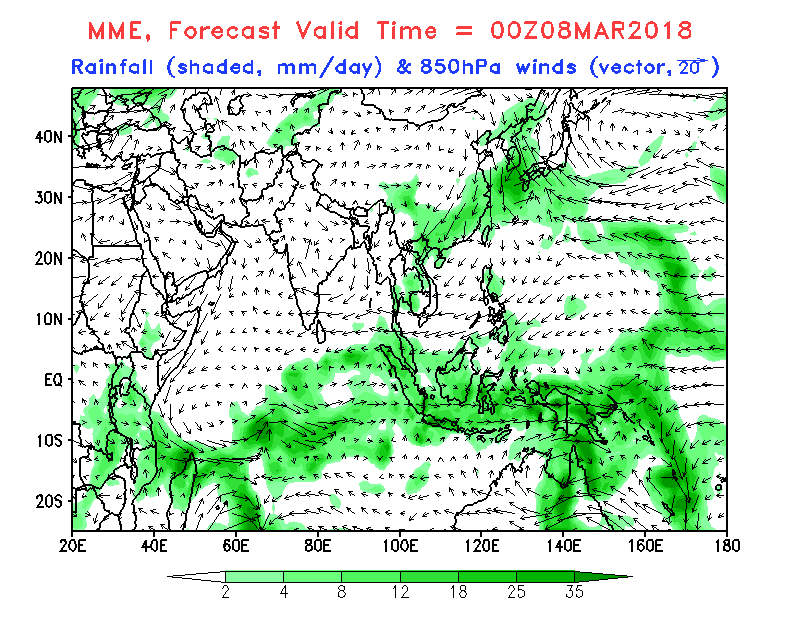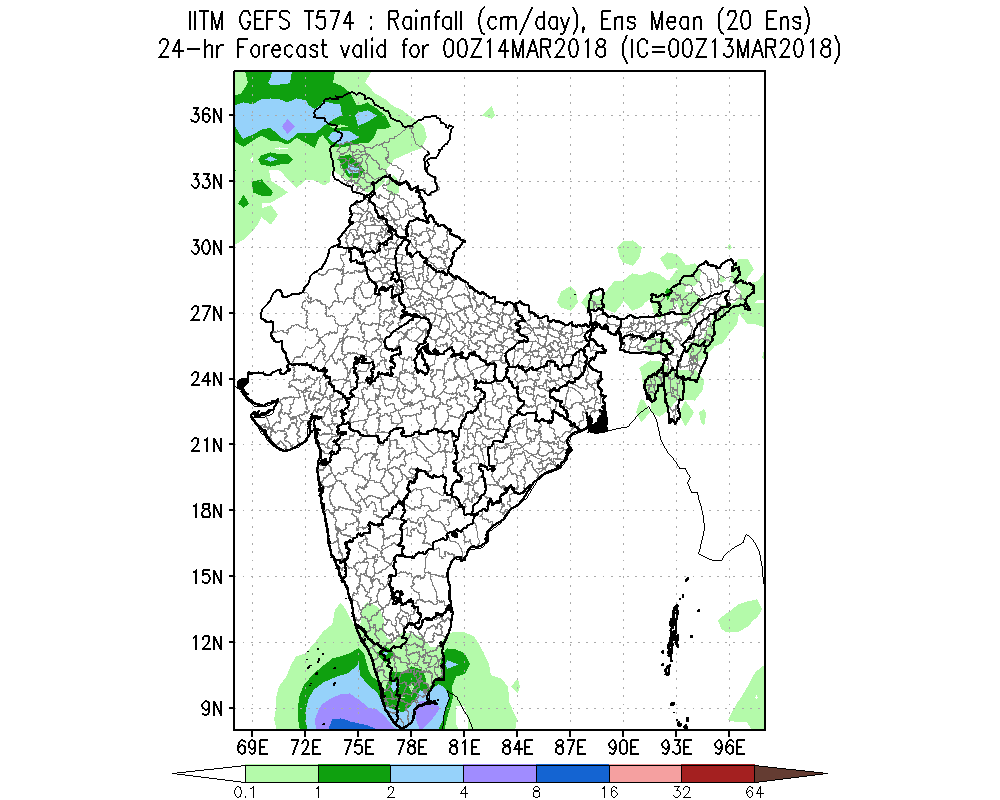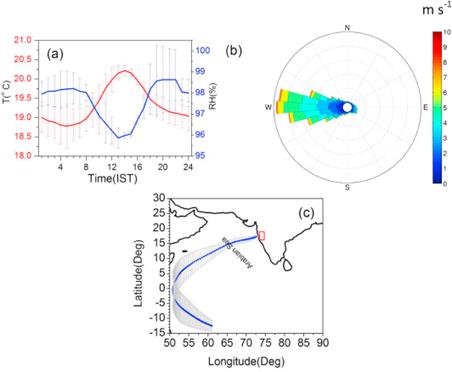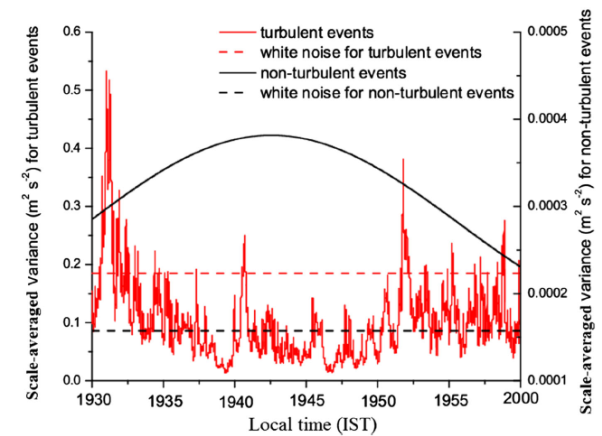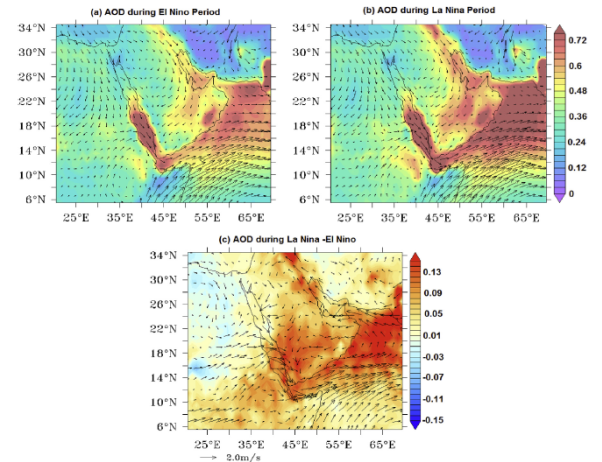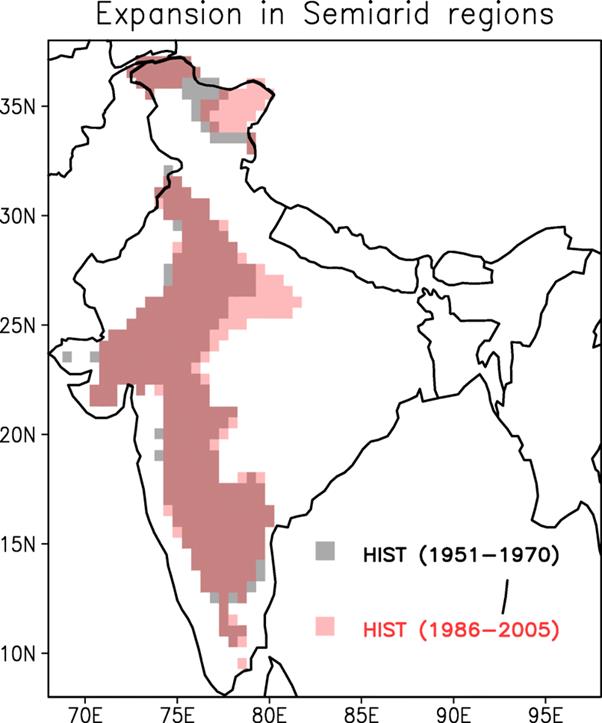SCIENCE LECTURE SERIES
Prof. R. Ananthakrishnan Seminar Series
Lecture-1 (15 Jan. 2018) |
Lecture-2 (9 Mar. 2018)
Lecture-3 (12 Apr. 2018) |
Lecture-6 (13 Jul. 2018)
RAC Meeting : POSTERS
IITM Research Report
The 10-20 day intraseasonal variation of the South Asian summer monsoon simulated by GFDL models in the AMIP experiment of CMIP5, June 2018, Sujata Mandke et.al.
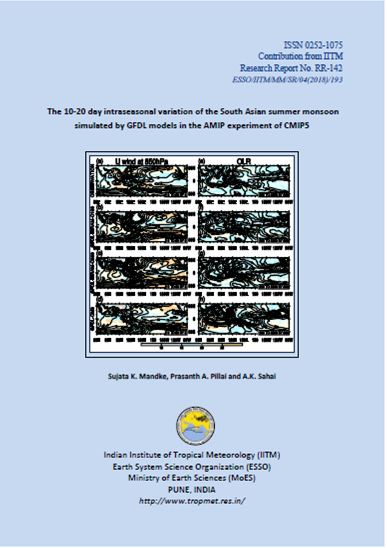 Read More
Read More
IITM Publication Highlights
Coupled model fidelity in capturing atmospheric internal processes during organization and intensification of boreal summer intra-seasonal oscillation
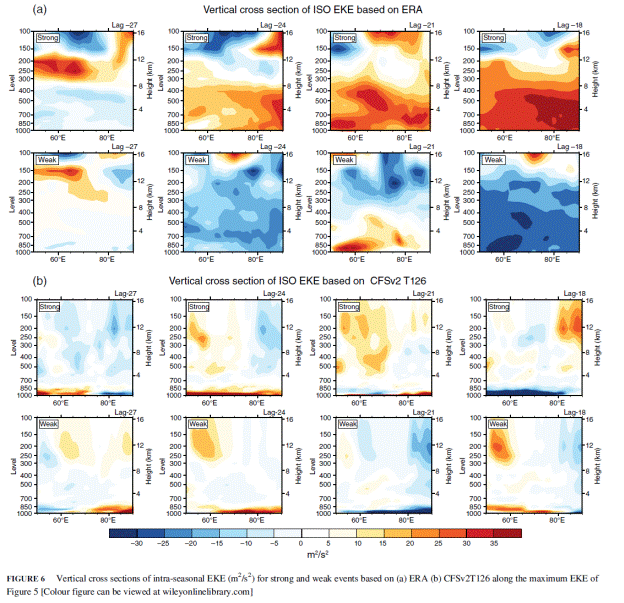 The study investigates the Climate Forecast System version 2 (CFSv2) model fidelity in capturing large-scale dynamical field and the energy conversion processes during organization and intensification of Boreal Summer Intra-Seasonal Oscillation (BSISO). Experiment is carried out to make 10-year free run to evaluate the model. Based on rainfall analyses, two types of events are defined one strong and other with weaker intensity. The result reveals that model over estimates the BSISO intensity starting from the initial phase. Strong events based on MERRA data show a persistent increasing lower-level moisture convergence with respect to convection centre (CC) and a collocated vertical velocity with CC. However, model moisture convergence and vertical velocity are slightly stronger than observation at the initial phase but it is not persisting in the subsequent lags. The analysis of eddy kinetic energy (EKE) budget equation shows that the model intra-seasonal EKE is very weak at 850 hPa level. The vertical structure of EKE has shown that a positive EKE at the lower to middle troposphere increases in the subsequent lags but it is very weak for model. The analysis of each term of EKE budget has shown that the barotropic energy conversion (?CK) and convergence of eddy geopotential fluxes (?FG) are the dominant contributors for positive EKE tendency in the ERA analysis and both the terms increase as the BSISO approaches towards its organized and intense phase. However for model, the above terms are very weak. The EKE advection through large-scale background flow (?AM) and synoptic-scale eddy (?AE) adds negatively to the EKE tendency for strong events. However for model, the magnitudes of the above terms are higher than that of the observation for both strong and weak events. Thus, the model has deficiency in capturing the dynamical processes and the energy conversion processes properly.
(Sahadat Sarkar, P. Mukhopadhyay , R. Phani Murali Krishna, Somenath Dutta, August 2018)
The study investigates the Climate Forecast System version 2 (CFSv2) model fidelity in capturing large-scale dynamical field and the energy conversion processes during organization and intensification of Boreal Summer Intra-Seasonal Oscillation (BSISO). Experiment is carried out to make 10-year free run to evaluate the model. Based on rainfall analyses, two types of events are defined one strong and other with weaker intensity. The result reveals that model over estimates the BSISO intensity starting from the initial phase. Strong events based on MERRA data show a persistent increasing lower-level moisture convergence with respect to convection centre (CC) and a collocated vertical velocity with CC. However, model moisture convergence and vertical velocity are slightly stronger than observation at the initial phase but it is not persisting in the subsequent lags. The analysis of eddy kinetic energy (EKE) budget equation shows that the model intra-seasonal EKE is very weak at 850 hPa level. The vertical structure of EKE has shown that a positive EKE at the lower to middle troposphere increases in the subsequent lags but it is very weak for model. The analysis of each term of EKE budget has shown that the barotropic energy conversion (?CK) and convergence of eddy geopotential fluxes (?FG) are the dominant contributors for positive EKE tendency in the ERA analysis and both the terms increase as the BSISO approaches towards its organized and intense phase. However for model, the above terms are very weak. The EKE advection through large-scale background flow (?AM) and synoptic-scale eddy (?AE) adds negatively to the EKE tendency for strong events. However for model, the magnitudes of the above terms are higher than that of the observation for both strong and weak events. Thus, the model has deficiency in capturing the dynamical processes and the energy conversion processes properly.
(Sahadat Sarkar, P. Mukhopadhyay , R. Phani Murali Krishna, Somenath Dutta, August 2018) 
Tree-ring reconstruction of summer temperature of Sikkim Himalaya since 1705 C.E.
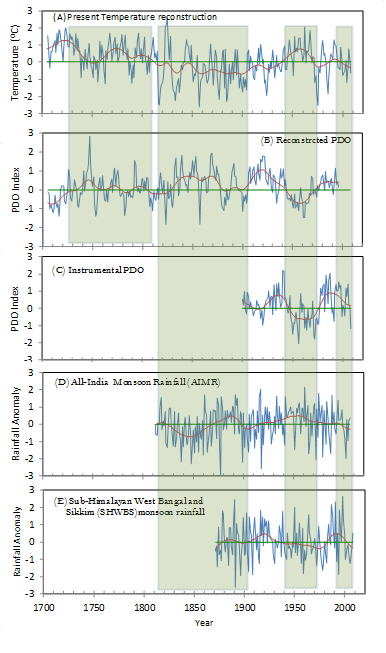 A 437-year Tsuga dumosa (D.Don) Eichler (i.e., Himalayan hemlock) tree-ring chronology for northern Sikkim and a subsequent summer (JAS) temperature reconstruction during the past 304 years is presented. Dendroclimatic analysis indicates a strong negative relationship between late-summer mean temperatures (July-August-September; JAS) and tree growth. This relationship enables us to reconstruct the JAS mean temperature over northern Sikkim since 1705 C.E. The 304-year (1705-2008 C.E.) reconstructed temperature series shows similar warm and cool epochs, which have been observed in many other temperature reconstructions in the region and other proxy records of glacial fluctuations. An overall steady decreasing trend in the regional surface temperature is observed since 1705 C.E., while an increasing trend with intermittent, short and cool epochs are noticed from 1850 C.E. to the present. Global teleconnections of the reconstructed temperature variations indicate the important roles of the Pacific Decadal Oscillation (PDO), El Niñouthern Oscillation (ENSO), and volcanic eruptions as drivers of temperature variations in the Sikkim region of the Himalayas.
(H. P. Borgaonkar, Naveen Gandhi, Somaru Ram, R. Krishnan, May 2018)
A 437-year Tsuga dumosa (D.Don) Eichler (i.e., Himalayan hemlock) tree-ring chronology for northern Sikkim and a subsequent summer (JAS) temperature reconstruction during the past 304 years is presented. Dendroclimatic analysis indicates a strong negative relationship between late-summer mean temperatures (July-August-September; JAS) and tree growth. This relationship enables us to reconstruct the JAS mean temperature over northern Sikkim since 1705 C.E. The 304-year (1705-2008 C.E.) reconstructed temperature series shows similar warm and cool epochs, which have been observed in many other temperature reconstructions in the region and other proxy records of glacial fluctuations. An overall steady decreasing trend in the regional surface temperature is observed since 1705 C.E., while an increasing trend with intermittent, short and cool epochs are noticed from 1850 C.E. to the present. Global teleconnections of the reconstructed temperature variations indicate the important roles of the Pacific Decadal Oscillation (PDO), El Niñouthern Oscillation (ENSO), and volcanic eruptions as drivers of temperature variations in the Sikkim region of the Himalayas.
(H. P. Borgaonkar, Naveen Gandhi, Somaru Ram, R. Krishnan, May 2018) 
Isotopic studies of plant transpiration
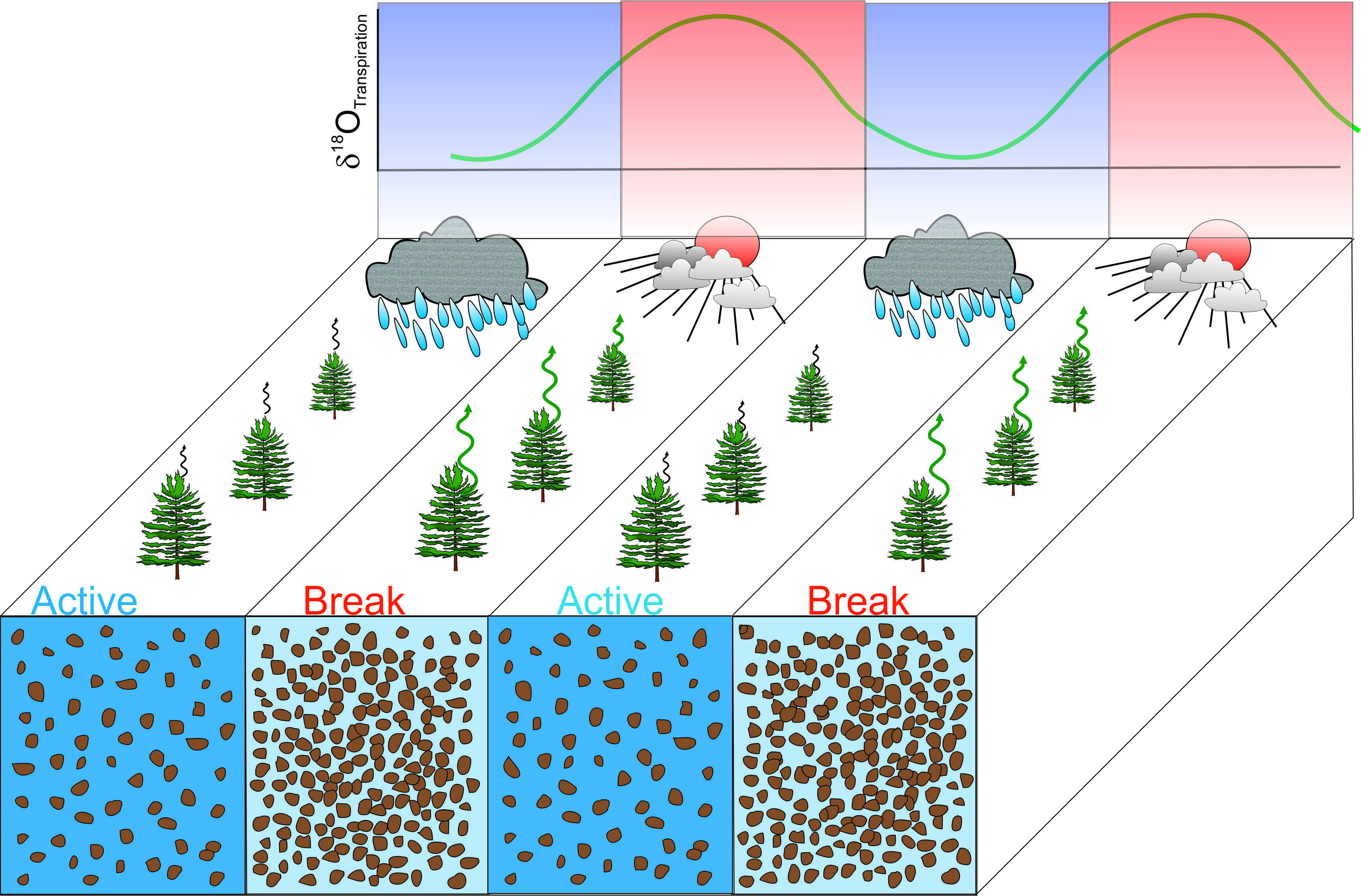 Isotopic analysis of rain water and transpired water on a few plants have been carried out during the monsoon season of 2016 and 2017 at IITM, Pune. The study shows that the oxygen isotopic compositions of the plant transpired water are strongly controlled by the soil water dynamics. During the active monsoon season, soil water content is increased which results in depleted isotopic values in the transpired water. On the other hand, during the break phases of monsoon, the soil water content is relatively low which leads to enriched isotopic values in plant transpired water.
The study has implication in identifying the monsoon break phases using bio-meteorological parameter, that is, transpiration. To our knowledge, such kind of study, that is the identification of active/break phases using a bio-meteorological parameter was not reported before.
Diagram: A schematic representation of the active and break phases during a monsoon season. During the active period, heavy rainfall helps increase the soil water content, as represented by blue shading. During this time soil evaporation is low and hence the soil water does not suffer significant changes in its isotopic values. On the other hand, during a break condition, low rainfall results in low soil water content (light blue shading) and in turn, high soil water evaporation. This causes enriched isotopic values in soil water, and in turn, the transpired water. The isotopic values of the transpired water are schematically represented by a sinusoidal variation as shown in the upper portion of the diagram.
(Chakraborty S., Belekar A.R., Datye A., Sinha N., June 2018)
Isotopic analysis of rain water and transpired water on a few plants have been carried out during the monsoon season of 2016 and 2017 at IITM, Pune. The study shows that the oxygen isotopic compositions of the plant transpired water are strongly controlled by the soil water dynamics. During the active monsoon season, soil water content is increased which results in depleted isotopic values in the transpired water. On the other hand, during the break phases of monsoon, the soil water content is relatively low which leads to enriched isotopic values in plant transpired water.
The study has implication in identifying the monsoon break phases using bio-meteorological parameter, that is, transpiration. To our knowledge, such kind of study, that is the identification of active/break phases using a bio-meteorological parameter was not reported before.
Diagram: A schematic representation of the active and break phases during a monsoon season. During the active period, heavy rainfall helps increase the soil water content, as represented by blue shading. During this time soil evaporation is low and hence the soil water does not suffer significant changes in its isotopic values. On the other hand, during a break condition, low rainfall results in low soil water content (light blue shading) and in turn, high soil water evaporation. This causes enriched isotopic values in soil water, and in turn, the transpired water. The isotopic values of the transpired water are schematically represented by a sinusoidal variation as shown in the upper portion of the diagram.
(Chakraborty S., Belekar A.R., Datye A., Sinha N., June 2018)
New Publications
IITM Events
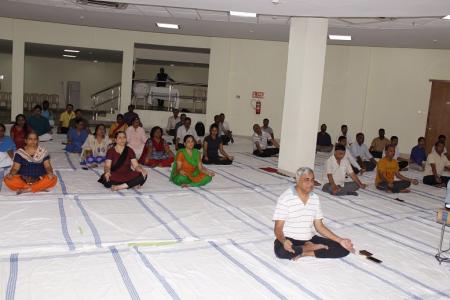
International Yoga Day celebration at IITM
IITM celebrated International Yoga Day on 21st June 2018 at its campus at Pashan Pune. On this occasion, Yoga expert Dr. Pranav Khawale and his team from National Institute of Naturopathy Pune, Ministry of Ayush, Govt. of India, visited IITM and conducted a Yoga session. Prof. Ravi. S Nanjundiah, Director IITM, along with IITM employees and their families attended this session. Various Yoga activities were performed during the session. As designed by the Ministry of Ayush, Govt. of India, Yoga protocol was practiced by including Prayer, performing Asanas, Pranayama and Mudra. Dr Khawale introduced the participants about Yoga and its History. He emphasized on the importance of Yoga in maintaining mental & physical well being in day- to-day lifestyle. IITM employees learned the asanas and discussed with the Expert about their common health issues. Director IITM addressed the gathering and narrated his experience by adopting Yoga in his daily life. He encouraged the employees to practice yoga to deal with stress, anxiety, etc.
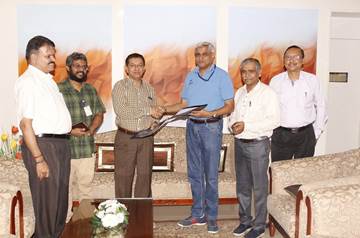
IITM signed MoU with NMU, Jalgaon for scientific collaboration
Memorandum of Understanding (MoU), between Indian Institute of Tropical Meteorology (IITM), Pune, India and North Maharashtra University (NMU), Umavi Nagar, Jalgaon, India was signed by the Director, IITM, Prof. Ravi S. Nanjundiah on 29 May, 2018. On behalf of NMU, Prof. S. N. Patil, Head of Department of Applied Geology, School of Environmental and Earth Sciences, NMU, Jalgaon was present at IITM. The initiatives by IITM for introducing the Atmospheric and Oceanic Science in the curriculum at Post-graduate level courses at NMU will be proven to be crucial for the development of the skilled manpower in time ahead.
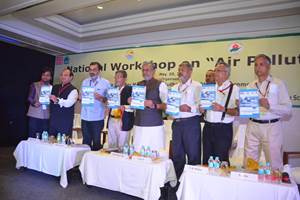
IITM provided expertise scientific assistance to Govt of Bihar
IITM provided scientific assistance to Bihar State Disaster Management Authority (BSDMA), Govt of Bihar on "Assessment of Air Quality Of Patna in various Micro-environments". This is for the first time such air quality assessment was made by Bihar State Disaster Management Authority (BSDMA) through Indian Institute of Tropical Meteorology (IITM), Pune, in collaboration with the Centre for Environment, Energy & Climate Change (CEECC) in Patna during 19 October - 28 November 2017. A technical report prepared by IITM was released by Shri Sushil Modi, Hon'ble Deputy Chief Minister of Bihar, Minister of Environment and Forest department, in presence of Chairman BSDMA, Principal Secretary BG, etc during the workshop on air pollution in Patna on 9th May 2018. Hon'ble Dy Chief Minister expressed gratitude to IITM and MoES for timely help in this regard.

CAIPEEX - Scientific cloud seeding experiment 2018
CAIPEEX Phase IV experiment has started on 3rd July 2018 and will be conducted for 120 days, depending on availability of suitable clouds. IITM has established an observational facility and a dual polarimetric C-band radar at NBNSCOE, Solapur, Maharashtra. A seeder and an instrumented research aircraft are being used to seed clouds and record the changes in clouds, leading to rainfall. This is for the first time, such science experiment is being conducted in the convective clouds over the tropics.
